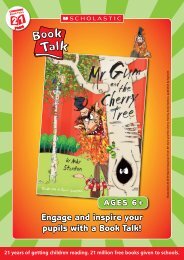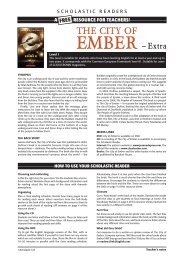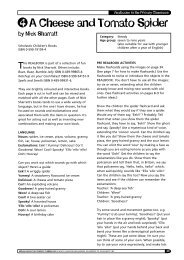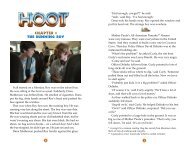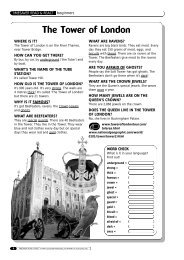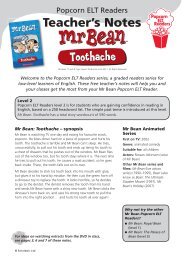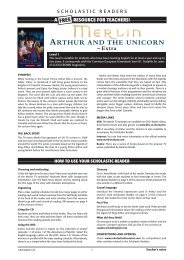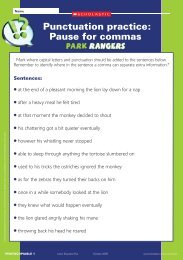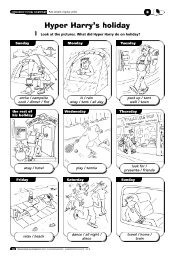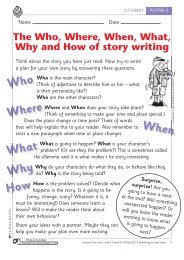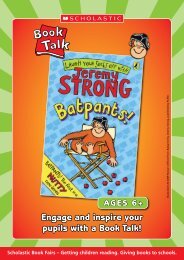Zoo: Teachers' notes - Scholastic
Zoo: Teachers' notes - Scholastic
Zoo: Teachers' notes - Scholastic
Create successful ePaper yourself
Turn your PDF publications into a flip-book with our unique Google optimized e-Paper software.
IMAGE TAKEN FROM ZOO BY ANTHONY BROWNE, PUBLISHED BY RED FOX, RANDOM HOUSE<strong>Zoo</strong>: Teachers’ <strong>notes</strong>Use these talking points to explore words and pictures inthe poster ‘<strong>Zoo</strong>’ taken from the book of the same name byChildren’s Laureate Anthony Browne.POSTER IMAGE TAKEN FROM ZOO BY ANTHONY BROWNE, PUBLISHED BY RED FOX, RANDOM HOUSEIntroducing the imageShow the children the posterfeaturing the image from <strong>Zoo</strong>by Anthony Browne. Ask for thechildren’s initial thoughts about thepicture – what do they notice aboutthe various characters?If it hasn’t already been alludedto, point out that many of thecharacters look like animals. Ask:How has the illustrator shown this?(Monkey hats, hairstyles, ears, eyes,and so on).Say that the reason the illustratormight have portrayed peopleas animals was to suggest thatsometimes we really are like animals– because of the way we look or act.Ask the children if there are timeswhen they act a bit like animals.(For example, hyenas when they arelaughing, lions when they’re brave,monkeys when they’re cheeky.)Animal additionsUsing their ideas from thediscussion above, invite the childrento draw a self portrait adding insubtle animal features in the sameway that Anthony Browne does in<strong>Zoo</strong>. Encourage them to think ofanimal body parts (ears, nose, eyes,tail, and so on) as well as animalpatterns and colours.Brave like a lionAsk the children to write a poemabout how they act a bit like animalsat different times. Discuss differentanimals and what personalitycharacteristics they are knownfor (for example, lions are brave,dolphins are friendly, dogs are loyal).You could provide a writing framefor children such as:When I feel brave, I am a ……When I feel frightened, I am a …..When I feel happy, I am a ….When I feel sad, I am a …..Pets like peopleDiscuss with the children howanimals are sometimes similar topeople, too. Ask who has pets athome and invite the children toshare with the rest of the class howtheir pets behave. Perhaps a petdog is a best friend, or a pet cat agood listener? Maybe they have aparrot who chatters all day long?Ask children who don’t have pets tosuggest how other animals behave,for example the ducks in the park.Invite the children to write a shortstory about an ordinary day butfrom an animal’s point of view, forexample, a pet or an animal in apark or zoo.Picture messagesDiscuss with the children howAnthony Browne uses images torepresent words and messages. Forexample, the image of the strongman on one t-shirt suggests thewearer is tough, while the eggimage on another t-shirt could implythat the wearer is an ‘egghead’ (aclever person who studies veryhard). Talk about the use of symbolsand images on signs that provideinformation or instructions. Can thechildren think of any signs that usepictures rather than words? (Forexample, road signs, safety signs,toilet signs.)Design a signInvite the children to design somesigns for the school to showparents, teachers and visitors whattype of school it is. For example, asimple smiley face could representa happy school, a sign with fruit oncould represent a healthy schoolor a sign with lots of people oncould represent a friendly school.Signs could be hand drawn orpainted, or the children could designthem using an art program on thecomputer. The fi nished signs couldthen be laminated and displayedaround the school.PHOTOCOPIABLE 1www.scholastic.co.uk/childedplusOctober 2009Child Education Plus
Animals up closeMany of the people in the ‘<strong>Zoo</strong>’ poster have animal-like features. Look at the closeupimages below of real-life animals. Work out what the animals are and then findthe people who look like each of the animals in the poster image. Why not cut outthe images below and draw what you think the rest of the animal looks like?IMAGES © PHOTOS.COM/JUPITER IMAGES/GETTY IMAGES; ANSWERS FROM TOP LEFT: LION, DOG, MONKEY (BABBOON), CAT, GORILLA, CHICKENPHOTOCOPIABLE 2www.scholastic.co.uk/childedplusOctober 2009Child Education Plus
The jungle raceRead this animal poem in the playground or PE hall and invite children torespond by making suitable movements to represent each ofthe jungle animals.Monkey, monkey, won’t you follow meSwing through the jungle – tree to treeElephant stomps and stamps alongTrumpet raised in elephant songToucan soars with wings to fl yA rainbow in the jungle skySnake moves smoothly, silent, slickDon’t get bitten, must be quickWORDS © SCHOLASTIC LTD; LEAF BORDER © KATIE WEST/WWW.ISTOCKPHOTO.COMPanther runs at lightning paceFirst to win the jungle race.PHOTOCOPIABLE 3www.scholastic.co.uk/childedplusOctober 2009Child Education Plus



